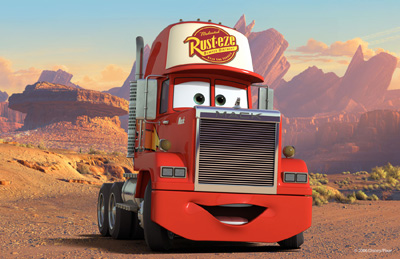The evolutionary and cognitive basis of the cultural success of garbage trucks among western toddler
The other day, I was browsing Youtube, looking for toddler's cartoons to entertain my 18 months old boy. I was not very optimistic though: Like many toddlers, my son's attention span rarely exceeds a couple of minutes... My best bet was that he would be interested in cartoons involving trucks and cars because these are the things that excite him most in real life. I did find cartoons of that kind but he turned out not to be terribly excited until I inadvertently clicked on a link suggested by Youtube [1] which captured his attention for 9 long minutes. He then begged to watch the same video again... That's 18 minutes overall... much longer than anything he had previously been exposed to and guess what the video was about: A series of demonstration of garbage trucks...
And that's not all! There is also Garbage Trucks I [2] and Garbage Trucks III [3] (and yes, we watched them all).
Note that the video is especially adapted (albeit probably not intentionally) to toddlers: the same action is repeated again and again so that you know what to expect and you can enjoy the pleasure of repetition.
A bit worried about my son's centre of interest, I looked at the comments and quickly got reassured: it is apparently the favourite video of many children. Moreover, it has been watched more than two million times! Yes, two million times (That is roughly the success of Noam Chomsky's most watched videos).
So I thought that there was something to explain there and that I should share my question with my fellow ICCI readers: What makes garbage trucks so culturally successful? On which cognitive function do they tap? Why are they "cheesecake for the mind"?
The question may be more difficult than it appears at first sight. Take dinosaurs for instance, another successful item of child culture: They clearly belong to the actual domain of our intuitive biology. Children like dinosaurs in the same way they like dogs, cows and sheeps: dinosaurs meet the input requirements of their intuitive biology. In consequence, children like to fill their database with information (their noise, their colors, etc.) and they like to classify them in genre, sub-genres and so on.
DINO PICTURE
Cheesecake for the mind I
Same for kittens and little ponies. It's easy to see why they are so successful. They tap onto children's (and especially girls') drive for cute beings, a drive that may have evolved to help children take care of younger siblings (children do not need to be old enough to be able to actually take care of babies, they can have this preference while being too young to apply it in real life).
 Cheesecake for the mind II
Cheesecake for the mind II
Things are more complicated for trucks (not to mention garbage trucks). Trucks are not like animals (and they are not very cute either). So why do children like them so much?
Here is a speculative answer. Young boys (as well as men) would have an innate bias toward physical activities: pushing, throwing, running, jumping, etc. Presumably, being interested in physical exercise helped our ancestors -- especially men -- to survive in their environment (this is corroborated by the sexual asymetry in terms of muscular mass). This would explain why men like rough-and-tumble play when they are young and sports when they are older. And this would explain why they like trucks when they are toddlers: you can move trucks, push them, fill them with stuffs, and so on. Like many other inventions, they allow young boys to extend the domain of physical activities.
If this theory is correct, we should find a strong sexual asymetry regarding the use of trucks. And indeed, psychologists (see here for instance) have observed strong sex difference. It is actually one of the most robust human behavioral sex differences, with young boys using their toys to do physical activities (throwing them, pushing them, etc.) and girls using their toys to tell stories or do social activities.
Recent studies suggest that this sex difference is even present among non human primates.
 Cheesecake for the (primate) mind
Cheesecake for the (primate) mind
Young male monkeys do not like the same toys as young female monkeys (for studies in the wild, see Matsuzawa's anecdotes [4] and the study that just appeared in Current Biology). This is especially interesting as there is no evidence for socialization of specific gendered activities among monkeys.
Another set of research has looked at hormonal influence on toy preferences. In a recent study, Auyeung et al. measured testosterone levels in the amniotic fluid of pregnant women. Then they tracked the children for several years after birth. Testosterone levels were higher in male fetuses, but even female fetuses were exposed to some testosterone. And fetal testosterone was linked with rough-and-tumble play. The higher the testosterone levels, the more likely the child was to exhibit "male-typical" behaviors (e.g. throwing, pushing toys). Similarly, girls with congenital adrenal hyperplasia (CAH), an inherited enzymatic defect preventing glucocorticoid production that results in elevated prenatal adrenal androgen secretion, show more boy-typical toy preferences than do their unaffected sisters or control girls. This preference is evident in CAH girls who look like and are reared as girls and despite the fact that most of these girls have typical female gender identity.
To sum up, there are good reasons to think that the cultural success of toys is partly due to our evolutionary background (while not being particularly adaptive). Note that this does not mean that boys should always prefer trucks and girls dolls. Toys are not essentially sexual, they are sexualized by children who choose them because of their biases. Actually, my son has a pushchair and a doll and he is fine with that: he puts his trucks in the pushchair and enthusiastically runs around the house with it.
So far, so good. But does this explain my son's preference for trucks? After all, not only does he like playing with trucks, he likes watching trucks. Can the by-product theory make sense of this preference too? My guess is that in the same way males like playing sports and watching sports because it involves physical activities, they like playing with trucks and watching trucks because trucks are naturally related to "physical activities" (for lack of a better term).
MONSTER TRUCKS PICTURE (maryboroughspeedway.com)
Cheesecake for the (adult male) mind
Now, if you ask: Why garbage trucks in particular? I would retort that you probably haven't carefully watched the video whilst trying to empathize with a young boy. I mean, the garbage truck has wheels, carries garbage, catches bins with its mechanical arm, pours the garbage in the dumpster and so on. That's better than a superhero!
 The ultimate cheesecake for the (young boy) mind
The ultimate cheesecake for the (young boy) mind
(Note: For those interested in scientific (or evidence-based) approaches to parenting, there are now very interesting websites on that topic! [5])
[1] "Garbage Trucks Part II" (video). Source: Youtube @georgewuzheer. January 31, 2009.
[2] "Garbage Trucks Part I" (video). Source: Youtube @georgewuzheer. January 21, 2007.
[3] "Garbage Trucks Part III" (video). Source: Youtube @georgewuzheer. June 6, 2010.
[4] Matsuzawa, T. (2008). Essay on evolutionary neighbors: 5. Doll play in wild chimpanzees.
[5] http://www.parentingscience.com



Konrad Talmont-Kaminski 28 December 2010 (13:22)
It's hardly a well-formed suggestion, but I would expect that the interest the boys show in trucks would also have something to do with trucks being recognised as tools. Very large, very powerful, very effective tools. Interesting, though, that what the tools are actually for should have apparently little significance.
Nicolas Baumard 29 December 2010 (10:03)
Yes, it's also what I thought at first, namely that the cultural success of trucks was partly based on our intuitive teleology (i.e. the detection of goals in object, the 'intentional stance' as Dennett says). But the study on monkeys made me change my minds: Monkeys are not particularly prone to teleology and still, they are interested in physical activities involving objects. I thus thought that it was more about doing physical stuff than about using tools. Anothet argument is that young males (human and non human) are happy playing with dolls: they throw them, push them, carry them. They only choose trucks because trucks fit more with there activities (as one of the researcher note: "it's not very interesting to push dolls!").
Tyler Tretsven 28 June 2011 (20:30)
This is a late comment, but as to why garbage trucks may be cheesecake to the minds of toddlers, I think that the answer may relate more to the intuitive biological mechanisms that were mentioned early on. You say that trucks do not resemble animals, and thus presumably do not activate intuitive biological mechanisms. But I am not sure that I'm convinced. Trucks can vaguely be seen to resemble large quadrupeds; at least similarly enough that they could potentially fulfill the necessary input conditions (connected to the ground by several wheels or “limbs,” a discernible front and back, a front grill and divided windshield that might resemble a mouth and set of eyes, “consumes” garbage, self-propelled goal-directed movement). They're not similar enough that children would be fooled into thinking that they're animals, but they share enough features with animals that they may activate the mechanisms that cause children to pay attention to animals in order to gain information about their behavior that can be useful in the future. But what seems to me to be more important is the size of garbage trucks, which, like the most popular dinosaurs, are enormous. Archaeology has shown that earlier humans relied on hunting large game, to the point that they have the tendency to hunt large mammals to extinction when they enter new environments like North America. Is it possible that some sort of bias may be present in intuitive biology that would predispose children to not just acquire as much information about animals as possible, but to pay particular attention to the types of animals that could be good candidates for large game? Garbage trucks and dinosaurs would certainly fall within the domain of such a bias (though predator avoidance may motivate the desire to learn about the more vicious dinosaurs). This is also speculative, but it seems to me to be plausible.
Nicolas Baumard 29 June 2011 (16:30)
Thanks for this interesting comment! Actually, you made me change my mind! When I thought about intuitive biology, I had in mind the fact that we are interested in classifying animals and so on (which is different than playing with them). But I did not see that there was indeed a certain bias: boys are more interested in big animals, the kind of animals that were interesting during the paleolithic (as cave art clearly suggests). So you might be right! (and it can also be a combination of features: trucks are big animals you can easily play with).